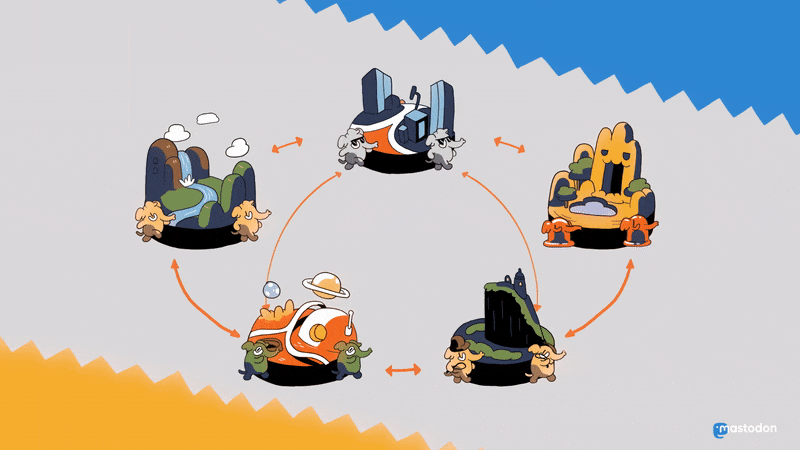Feedseer is an instance of Mastodon that gives users more control over their feeds.
This is achieved using qualifiers and actions. Qualifiers provide a way to analyze the content of a toot and take action based on that. Based on a qualifier's output, actions can be configured to either hide a toot or move it to a folder. Users can create their own qualifiers to analyze different types of toots or provide interesting insights on a toot's content.
Feedseer is in Private Alpha. Things will break sometimes and your data may be lost. Our sincere apologies in advance.
- Navigate to Qualifier Store.
- Click on a qualifier
nameto see a qualifier's details. - Read the qualifier
descriptionto understand the type of analysis performed on a toot. - Qualifier
endpointis where a qualifier is hosted. See theHow to create qualifierssection below to understand how qualifiers access your toots. Qualifiers cannot access your profile information. - Add a qualifier to your profile by clicking the
Installbutton. - Click the
Add filterbutton to set up an action based on a qualifier's response. The response can betrueorfalsebased on whether or not a toot is related to what the qualifier was looking for.- Select a filter condition based on the qualifier's response.
- Select the action to be taken on a toot that qualifies:
- Set the action to
Skip Inboxto remove it from your timelines. - Select
Move to folderand provide a folder name, to move the toot to a folder.
- Set the action to
Savethe qualifier.- You can update your qualifier's configuration here.
Please write a review for the qualifiers you use so that others can benefit from it. Also, mention the version of qualifier you are reviewing.
- Navigate to this page.
- Click on
Add qualifierbutton. - Provide a good
nameanddescriptionfor your qualifier.Descriptionshould include the kind of content a qualifier analyzes and the corresponding response (trueorfalse) it returns.
Endpointis the HTTPS URL that will be called with a toot's content.- Request will have a
content-type: application/jsonheader. - Request body format will be:
- Request will have a
{
"text": "Hello seers!"
}
- Response body format (
content-type: application/json) should be:
{
"result": true or false (Boolean)
}
HTTP Headerswill be set on the request sent to your endpoint. It can be used to set authentication headers.Versioncan be used to indicate improvements to your qualifier. This helps users review a specific version of a qualifier.- Select a
categoryfor the qualifier from the provided list. Saveyour qualifier.
A qualifier will be called only once per toot.
- Provide more qualifiers out-of-the-box.
- Media toots with qualifiers.
- Granular controls over enabling qualifiers.
Mastodon is a free, open-source social network server based on ActivityPub. Follow friends and discover new ones. Publish anything you want: links, pictures, text, video. All servers of Mastodon are interoperable as a federated network, i.e. users on one server can seamlessly communicate with users from another one. This includes non-Mastodon software that also implements ActivityPub!
Click below to learn more in a video:
- Project homepage 🐘
- Support the development via Patreon
- View sponsors
- Blog
- Documentation
- Browse Mastodon servers
- Browse Mastodon apps
No vendor lock-in: Fully interoperable with any conforming platform
It doesn't have to be Mastodon, whatever implements ActivityPub is part of the social network! Learn more
Real-time, chronological timeline updates
See the updates of people you're following appear in real-time in the UI via WebSockets. There's a firehose view as well!
Media attachments like images and short videos
Upload and view images and WebM/MP4 videos attached to the updates. Videos with no audio track are treated like GIFs; normal videos are looped - like vines!
Safety and moderation tools
Private posts, locked accounts, phrase filtering, muting, blocking and all sorts of other features, along with a reporting and moderation system. Learn more
OAuth2 and a straightforward REST API
Mastodon acts as an OAuth2 provider so 3rd party apps can use the REST and Streaming APIs, resulting in a rich app ecosystem with a lot of choice!
Tech stack:
- Ruby on Rails powers the REST API and other web pages
- React.js and Redux are used for the dynamic parts of the interface
- Node.js powers the streaming API
Requirements:
- PostgreSQL 9.5+
- Redis
- Ruby 2.4+
- Node.js 8+
The repository includes deployment configurations for Docker and docker-compose, but also a few specific platforms like Heroku, Scalingo, and Nanobox. The stand-alone installation guide is available in the documentation.
A Vagrant configuration is included for development purposes.
Mastodon is free, open source software licensed under AGPLv3.
You can open issues for bugs you've found or features you think are missing. You can also submit pull requests to this repository, or submit translations using Weblate. To get started, take a look at CONTRIBUTING.md
IRC channel: #mastodon on irc.freenode.net
Copyright (C) 2016-2018 Eugen Rochko & other Mastodon contributors (see AUTHORS.md)
This program is free software: you can redistribute it and/or modify it under the terms of the GNU Affero General Public License as published by the Free Software Foundation, either version 3 of the License, or (at your option) any later version.
This program is distributed in the hope that it will be useful, but WITHOUT ANY WARRANTY; without even the implied warranty of MERCHANTABILITY or FITNESS FOR A PARTICULAR PURPOSE. See the GNU Affero General Public License for more details.
You should have received a copy of the GNU Affero General Public License along with this program. If not, see https://www.gnu.org/licenses/.





